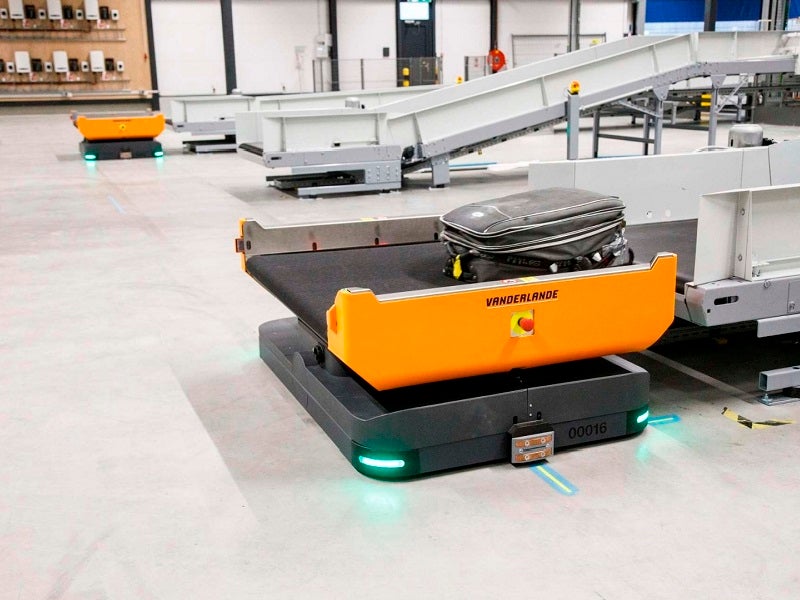
Dozens of small robotic vehicles carrying suitcases criss-cross a vast, airy warehouse – plucking baggage from conveyor belts before darting off towards X-ray security scanners and then delivering it to the right output location.
The scene – shown in a promotional video from the Dutch logistics automation specialist Vanderlande – looks like something out of a science fiction movie. But it is in fact an already operational automated baggage handling system that could transform how airports work in the future.

Discover B2B Marketing That Performs
Combine business intelligence and editorial excellence to reach engaged professionals across 36 leading media platforms.
Known as FLEET, the Vanderlande system seeks to replace the need for fixed conveyors and sorting systems – a process that is buckling at the seams as more than 4 billion passengers take to the sky each year and new hold baggage screening regulations prove challenging and costly for some airports.
According to the most recent statistics from SITE – an aviation communications and technology company – roughly 22 million bags were lost in 2016, affecting around six in every 1,000 passengers. While this number is half the rate of 2007, it is still a sizeable percentage that airports are keen to bring down as passenger numbers soar.
“Airports must adapt rapidly and cope with a shortage of personnel, while maintaining seamless operations within a limited footprint,” says Vanderlande General Manager FLEET, Koen Evers.
“Fixed infrastructure and fragmented IT architecture are no longer the preferred solutions in an ever-evolving environment in which process fluctuations (and corresponding volume changes) must be accommodated.”

US Tariffs are shifting - will you react or anticipate?
Don’t let policy changes catch you off guard. Stay proactive with real-time data and expert analysis.
By GlobalData“Flexible and cost-effective”
With the FLEET system, intelligent autonomous vehicles carry single bags through the airport, determining the most optimal route for a given time and passenger. The technology is based on real-time data, with route planning continuously updated and optimised to obtain the highest possible throughput.
According to Vanderlande, the system is able to withstand “fluctuations in baggage flow characteristics, such as airline volume distribution or hot bag percentages”, as well as changing security and screening regulations.
If certain parts of an airport’s operations move to another area, for example, the vehicles can be shifted to where they are needed most. FLEET can also act as a temporary baggage solution for peak periods or during phased construction projects.
“Due to FLEET’s configuration, adding vehicles or changing routes is easy, resulting in a scalable and flexible solution,” says Evers. “It has been designed to seamlessly grow alongside an airport, match its operations and peak flows, and allow it to adapt to changing security and screening regulations without interrupting operations.”
The flexibility of the system means it is also cost-effective. Because airports can adapt the number of vehicles and routes to their specific capacity needs, having unused assets on their balance sheets “is a problem that can be consigned to history,” says Evers.
“When the needs of an airport or security regulations change, FLEET can adapt to the new situation,” he says. In this way, it contributes strongly to improved asset utilisation.”
From Rotterdam to Hong Kong
The FLEET system was first introduced to the market in 2017 at inter airport – an international exhibition for airport equipment, technology, design and services. The vehicles were then built and tested in-house at Veghel, Vanderlande’s headquarters in The Netherlands, before being put into use at Rotterdam The Hague Airport (RTHA).
According to Evers the first installation was relatively straightforward, with the vehicles driving around their new home almost immediately. A few months after the project began, the CEO of RTHA, Ron Louwerse certainly appeared satisfied.
“For us, it was important to have a flexible, efficient and sustainable system that could be scaled up and down as required,” he said at a press conference in March.
“We needed a new baggage system because the current one was outdated, but we needed it to be flexible enough to manage future growth. FLEET gave us the opportunity to trial a system that was independent of the actual number of bags.”
Real-world experience
The installation at RTHA, alongside projects at Lelystad Airport in the Netherlands and another airport in the USA, have produced invaluable insights that have helped shape the FLEET system, Koen says.
“Our Value Centre uses global insights gained from our cross-site activities to make daily improvements,” he says. “Through these, system, maintenance and operational improvements can be made daily, as well as reductions to the total cost of ownership (TCO). By using central intelligence and a standard platform, every FLEET user is connected and benefits from continuous improvement.”
A new partnership agreement signed with Airport Authority Hong Kong will soon test the system in an even more strenuous setting: Hong Kong International Airport (HKIA), one of the fastest growing airports in the world.
The partnership will allow Vanderlande to further modify and adapt FLEET, while HKIA will be able to see how autonomous vehicles could help improve the efficiency of its baggage handling processes as well as the working conditions for its ground staff.
“We are delighted to join forces on this programme that will help us to realise our aspiration of being a leader in technology and innovation among international airports,” said Steven Yiu, deputy director of service delivery at AAHK.
Vanderlande’s executive vice president of airports Andrew Manship added: “Ultimately, our aim is to enhance the passenger experience, while improving efficiency and we have full confidence in FLEET’s capacity to deliver impressive results at one of the fastest growing airports in the world. This cooperation agreement with HKIA will be another important step in its further development.”





